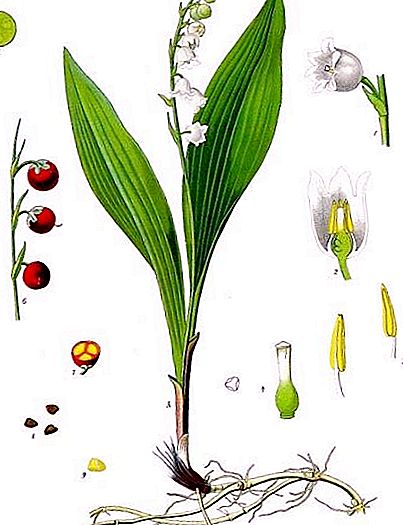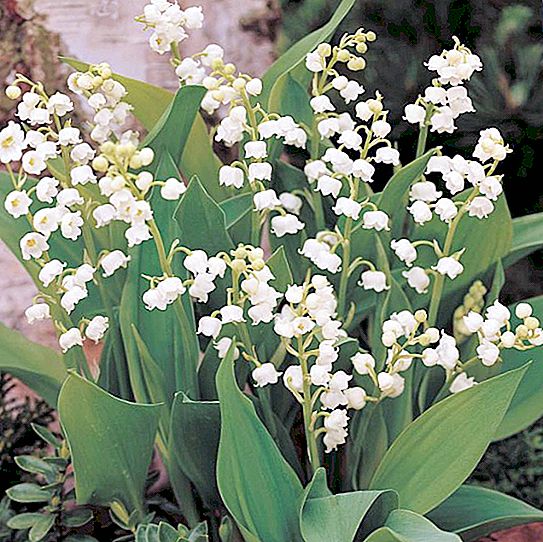One of the most beautiful forest plants is May lily of the valley. The description of this delicate white flower is often found among poets and novelists, it is painted on canvases by artists. It has many popular names: hare ears, wolf violet, silver. The flower grows in deciduous and pine forests, creating vast white-green glades during the May bloom.
Lilies of the valley. View description

Forest lily of the valley is a perennial herb. The area of its growth is almost the entire territory of Europe, Siberia, the Far East, and also the Japanese islands. True, some experts rank Japanese and Far Eastern flowers as another subspecies.
According to the botanical classification, May lily of the valley belongs to the class of monocotyledonous plants, and the lily family (Convallaria belonged to it earlier) has recently been replaced by the asparagus family. The main reason is the mismatch of the fruit of this flower with a characteristic species for the family. True lily flowers have a box, while lily of the valley have a berry.
Breeding in nature
Its reproduction occurs using the root system. The roots are very thin and quite long. Possessing a great ability to branch during growth, the root system of the convalia is able to quickly form a whole meadow from one planted bush. Moreover, where the lily of the valley grows, there are practically no other herbaceous plants, since it completely displaces them. Life expectancy is over forty years.
An shoot from two leaves enclosed in a rosette begins to grow from the root. Leaflets elongated and pointed at the tips, juicy, bright green. In the root area are framed by small scales. In the first year after the appearance of leaves, there is no flowering. A flower appears only in the second or even third year.
Strange flowers
Lilies of the valley have soft white, fragrant flowers. Appear depending on the place of growth in May or in the month of June. Initially, a thin green arrow begins to grow from a leaf outlet - a peduncle. Small green buds gradually appear on it, which form a one-sided loose flower brush. The flowers themselves are in the form of a six-toed bell of white color. The plant blooms for a long time - 2-3 weeks. After flowering, fruits in the form of an orange-red berry are tied. They reach full maturity by the beginning of September. Lily of the valley berries are poisonous.
Variety of varieties

Convalia is a fairly popular garden flower. It has been cultivated since the 16th century and to date, quite a lot of varieties have been bred. They are distinguished by the rich color of the flower, for example, Rosea has a soft pink bell, as well as the number of flowers on the peduncle, for example, Flore Plena has a very large number. In addition, there are lilies of the valley that remain beautiful even after flowering. For example, Convallária Albostriata has large green leaves with white veins. They are widely used to decorate flower beds that are located in the shade.
How to grow it in your own garden?
In nature, lilies of the valley grow in the forest, in the clearings and edges. How to grow a lily of the valley on your personal plot? Planting of this flower is made in the autumn, but can be planted in the spring. For planting, a shaded area of the garden is selected. Since the flower propagates using the root system, this method is more preferable. However, the seating of the flower is also possible with the help of seeds.

Where does lily of the valley grow? It can grow on almost any soil, but in wetlands it is poorly accepted. When planting, the depth of incorporation of the root process is also taken into account: it should not exceed three centimeters. It is also not recommended to thicken the planting - this can lead to damage to the seedlings by gray rot.

Plant care is simple. Lilies of the valley, the description of which characterizes them as shade-tolerant and frost-resistant plants, love abundant watering and periodic top dressing with mineral fertilizers. It must be remembered that Convalia is able to multiply rapidly. Therefore, the plantation where the lily of the valley grows is necessarily subject to cleaning and thinning at least 1 time in 2 or 3 years. Otherwise, flowering may stop.
Description of pharmaceutical properties
Lily of the valley is a medicinal plant. In all its parts contains a large number of cardiac glycosides, which are characterized by high cardiological and biochemical activity. These are mainly convallotoxin and convalloside. In addition to good therapeutic properties, they are unstable, therefore, do not accumulate in human organs and tissues. Therefore, the extracts obtained from the processing of plant materials are used in medicines for the treatment of heart diseases. In addition, konvalia has a good calming effect, therefore, it is often prescribed in herbal preparations in combination with valerian, motherwort, hawthorn and their analogues.





